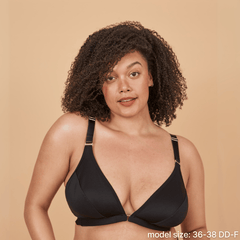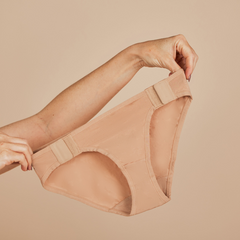Recovering from a rotator cuff injury can be challenging, especially when it comes to everyday tasks like dressing.
Whether you’re exploring post-surgery options or trying to handle day-to-day discomfort, finding the best bra for rotator cuff injury can significantly improve comfort and provide proper support.
We’re going to look at essential features for a bra for rotator cuff injuries and provide tips on finding the perfect fit.

Dressing With A Rotator Cuff Injury
Dressing with a rotator cuff injury requires careful consideration to avoid straining the injured shoulder. Traditional bras with back closures can be difficult and painful to put on. Therefore, adaptive clothing, particularly bras designed for ease and comfort, can be a key component of creating comfortable routines.
When you have a rotator cuff injury, the range of motion in your shoulder is significantly reduced, making tasks that involve lifting your arm or reaching behind your back particularly challenging. This limitation means that everyday activities, like dressing, can become not only difficult but also potentially harmful if they exacerbate the injury.
Traditional bras, especially those with back closures, often require a significant amount of shoulder movement to fasten and unfasten. This can lead to discomfort and even further injury if not managed properly. To avoid these issues, it's important to seek out bras specifically designed for people with limited mobility in their shoulders.
Adaptive bras, designed with features that simplify the dressing process, are an excellent solution. These bras typically include front closures, which eliminate the need to reach behind your back. Instead of struggling to connect hooks and eyes at an awkward angle, you can simply align and secure the front closure, making the process much more manageable.
Finding The Best Bra for Rotator Cuff Injury
Key Features To Look For
When searching for the best bra for rotator cuff injury, it’s important to prioritize features that enhance comfort, accessibility, and support. Here are some key features to look out for.
Front Fastening
Front-fastening bras are ideal for those with rotator cuff injuries as they eliminate the need to reach behind the back. This design allows for easier dressing and reduces strain on the shoulder. Front fastening bras can utilize Velcro, magnets or even zippers.
Velcro Fastenings
Velcro fastenings are the easiest option if you have a sling or have recently undergone surgery. They allow for a customized fit to account for any swelling and are very easy to adjust and manipulate throughout the day.
One-Handed Fastening and Unfastening
Bras that can be fastened and unfastened with one hand are invaluable for those recovering from a rotator cuff injury. These designs make it possible to dress independently, even when one arm is immobilized or has limited movement.
Soft Materials
Soft, breathable materials are essential for comfort, especially when dealing with sensitive or swollen areas around the shoulder. Look for bras made from fabrics that are gentle on the skin and provide adequate support without irritation.
Front-Adjusting Shoulder Straps
Front-adjusting shoulder straps allow for easy modifications to the fit without having to reach awkwardly. This feature ensures that the bra can be adjusted to provide optimal support and comfort as your recovery progresses.
Finding A Good Bra Fit
A well-fitting bra is crucial for those with rotator cuff injuries. Here are some tips for finding the right fit:
- Measure Carefully: Accurate measurements ensure a good fit. Use a soft measuring tape to measure your bust and band size.
- Recheck Measurements: Bodies can change, especially during recovery. Recheck your measurements periodically to ensure your bra continues to fit well.
- Try Different Styles: Not all bras fit the same. Trying different styles can help you find the one that offers the best support and comfort.

What’s The Best Bra for Rotator Cuff Injuries?
With this in mind, which bras are best for rotator cuff injuries?
The Springrose Adaptive Bra
We’ve designed The Springrose Adaptive Bra with limited mobility in mind. With the input of hundreds of women, as well as OTs and PTs, we’ve carefully created a bra that is as accessible as it is stylish.
Our bra is designed with front closures, adjustable straps, and soft, breathable fabric. Its adaptive design allows for one-handed fastening, making it an excellent choice for those with limited mobility. The wide, supportive straps distribute weight evenly, reducing pressure on the shoulders and enhancing comfort.
Alternative Options
Other options that are highly rated for those with rotator cuff injuries include:
- Dale Medical 705 Post-Surgical Bra: This medical bra has removable straps. This can be a great option immediately after surgery. It’s a very soft non-irritant material for when you need comfort rather than support.
- LIPOELASTIC PI Active - Medical Post Surgery Cotton Bra: This comfortable cotton post-surgery bra unfortunately has quite complicated fastens, but may still be suitable for those that need front closures with good support.
How To Fasten A Bra With One Arm

Putting on a bra with one arm can be tricky, but with the right techniques, it can be done smoothly. Here’s a step-by-step guide:
Step 1
Put the bra on like you would a jacket. Keep the Velcro fastenings attached on one side and open the front Velcro hook and loop strap on the side with your mobile hand or arm.
Step 2
Slide your less mobile arm through the shoulder strap hole. Rest the shoulder strap on your shoulder.
Step 3a
Using your mobile arm, reach back and slide your arm through the other shoulder strap hole, then bring the strap up to your shoulder.
Step 3b
If reaching back isn't possible, reach around the front of your body, over your non-mobile limb, to grasp the hanging shoulder strap. Move your arm in a circular motion around the back of your head, bringing the strap with you to the mobile side of your body.
Slide your arm through the hole and bring the shoulder strap up to your shoulder.
Step 4
Ensure the shoulder straps are not twisted and that the bra cups are positioned in front of or next to your breasts.
Step 5
Grasp the open Velcro strap and move it towards the metal rectangle on the other front strap. Loop the Velcro strap through the rectangle, pull it through, and attach the strap to the Velcro on the bra underband.
Check in the mirror or use your fingers to ensure no Velcro is visible to avoid it rubbing against your skin.
Finding the best bra for rotator cuff injury involves considering features that enhance ease of use and comfort.
The Springrose Adaptive Bra, with its front closures and adjustable features, stands out as an excellent choice.



